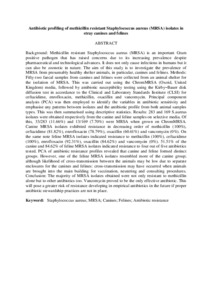Citation
Kanagarajah, Rajwin Raja and Lee, David Charles Weerasingam and Zhi, Daniel Fung Lee and Yusoff, Khatijah and Paramasivam, Sharmini Julita and Wai, Yee Low and Jeevaratnam, Kamalan and Swee, Hua Erin Lim
(2017)
Antibiotic profiling of methicillin resistant Staphylococcus aureus (MRSA) isolates in stray canines and felines.
Microbiology, Parasitology & Virology, 3.
art. no. 1412280.
pp. 1-10.
ISSN 2331-2025
Abstract
Background: Methicillin resistant Staphylococcus aureus (MRSA) is an important Gram positive pathogen that has raised concerns due to its increasing prevalence despite pharmaceutical and technological advances. It does not only cause infections in humans but it can also be zoonotic in nature. The aim of this study is to investigate the prevalence of MRSA from presumably healthy shelter animals, in particular, canines and felines. Methods: Fifty-two faecal samples from canines and felines were collected from an animal shelter for the isolation of MRSA. This was carried out using the ChromMRSA (Oxoid, United Kingdom) media, followed by antibiotic susceptibility testing using the Kirby–Bauer disk diffusion test in accordance to the Clinical and Laboratory Standards Institute (CLSI) for ceftazidime, enrofloxacin, methicillin, oxacillin and vancomycin. Principal component analysis (PCA) was then employed to identify the variables in antibiotic sensitivity and emphasise any patterns between isolates and the antibiotic profile from both animal samples types. This was then summarised using descriptive statistics. Results: 283 and 169 S.aureus isolates were obtained respectively from the canine and feline samples on selective media. Of this, 33/283 (11.66%) and 13/169 (7.70%) were MRSA when grown on ChromMRSA. Canine MRSA isolates exhibited resistance in decreasing order of methicillin (100%), ceftazidime (81.82%), enrofloxacin (78.79%), oxacillin (60.61%) and vancomycin (0%). On the same note feline MRSA isolates indicated resistance to methicillin (100%), ceftazidime (100%), enrofloxacin (92.31%), oxacillin (84.62%) and vancomycin (0%). 51.51% of the canine and 84.62% of feline MRSA isolates indicated resistance to four out of five antibiotics tested. PCA of antibiotic resistance profiles revealed that canine and feline formed distinct groups. However, one of the feline MRSA isolates resembled more of the canine group; although likelihood of cross-transmission between the animals may be low due to separate enclosures for the canines and felines: cross-transmission may have occurred when animals are brought into the main building for vaccination, neutering and consulting procedures. Conclusion: The majority of MRSA isolates obtained were not only resistant to methicillin alone but to other antibiotics too. Vancomycin proved to be the only effective antibiotic. This will pose a greater risk of resistance developing in empirical antibiotics in the future if proper antibiotic stewardship practices are not in place.
Download File
![[img]](http://psasir.upm.edu.my/60880/1.hassmallThumbnailVersion/Antibiotic%20profiling%20of%20methicillin%20resistant%20Staphylococcus%20aureus%20%28MRSA%29%20isolates%20in%20stray%20canines%20and%20felines.pdf)  Preview |
|
Text (Abstract)
Antibiotic profiling of methicillin resistant Staphylococcus aureus (MRSA) isolates in stray canines and felines.pdf
Download (109kB)
| Preview
|
|
Additional Metadata
Actions (login required)
 |
View Item |

